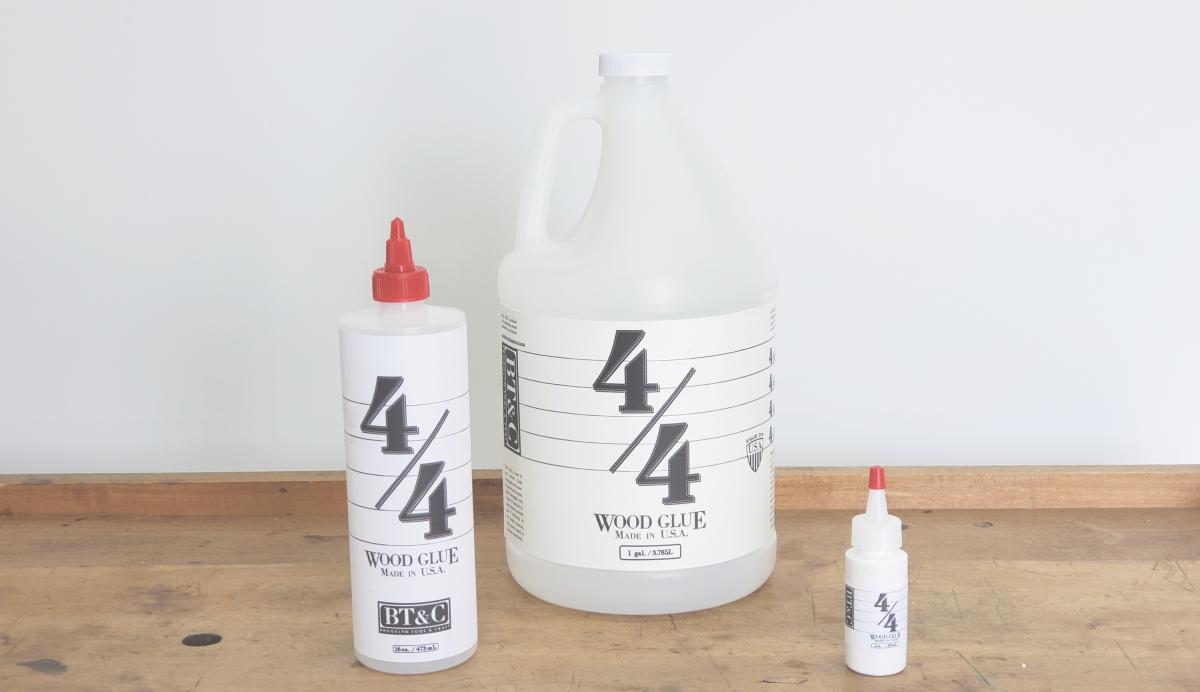|
|
08/07/2019 |

One of the great things about Tools for Working Wood is being able to think big. When we decided to sell glue - a regular request from our regular in-store customers - we realized we didn't need to restrict ourselves to buying Titebond. We could, and should, look around. And so we did. After a fair amount of testing and research, we found the glue we wanted to sell. Within a couple of weeks we will have our own brand of BT&C 4/4 glue in stock. It's not on the website yet, and I know the first thing that is coming to your mind is, "Glue?"
Actually yes. All glues have come in out of fashion as time and requirements have evolved. Up until the 20th century woodworking was done with hide glue. This is great stuff, reversible, mostly transparent to finishes, and the modern stuff we stock comes in all sorts of strengths and doesn't smell as bad as the old stuff. On the down side, you have to heat it up to work, and in the old days cabinetmakers would actually stick the parts of their project in the fire to heat it up so the glue would have more open time.
We also stock Old Brown which is regular hide glue mixed with urea so that at warm room temperature it is a liquid. This is one of my favorite glues except that it really needs to be warmed up a little to flow easily. It's also not inexpensive which is an issue in a large shop.
Casein glues, which are based on milk proteins, were also used in woodworking, but they have a long drying time. Of course you can make a flour and water glue that works well for light duty.
When polyvinyl acetate (PVA) glue, first invented in 1912, came on the market, it took over in woodworking shops because it didn't need cooking but was as strong as hide glue. The major downsides of PVA glues: they are not impervious to finishes and are also a lot less reversible than hide glue.
Lately we are seeing a lot of people using cyanoacrylate glue (CA) in one form or another. Invented in 1942, CA in a weak version is known as Crazy Glue. Its major claim to fame is that it dries in seconds, although the consumer versions are purposely slower drying and weaker because people used to glue their fingers together and things like that. In woodworking CA is increasingly handy in all sorts of formulas. We stock Fastcaps's 2P10 in all it's permutations. 2P10 is a two part CA glue where you apply glue on one part and activator on the other, and put them together. The joint reaches strength in 10 seconds. This is a monumentally good feature when a part is hard to clamp up.
Epoxy glues have also become very popular among woodworkers - especially for use with exotic and diverse materials. We are researching epoxies right now.
So there is a central role for adhesives in woodworking. Something to realize about a professional shop or factory is that long open time isn't always an advantage. You want to put it together, take off the clamps, and go on to the next thing. Factories with assembly lines use all sorts of UV and ultrasonic activated glues for that reason.
Back to our own glue story: I remember as a kid when Titebond first came out. Before that we all used Elmer's regular glue and then there was this new stuff that was supposedly stronger? And yellow. It was also thicker than Elmer's and didn't flow as much. It dried hard yellow. It's now the de facto wood glue of workshops.
But when we went looking for glue, we discovered that a lot of professional shops (not factories, but high volume custom shops) don't use Titebond. (Not even in big pails.) They buy 55 gallon drums of a PVA glue that has a short open time (5 minutes) and quick setup time (30 minutes or so) so that they don't have to wait overnight to take off clamps. This glue also happens to dry clear and only moderately rock-like , which means it's comparatively easy to scrape off without damaging the underlying (usually fragile veneer) and if there is just a bit left over, on prefinished material, as it is clear, there is no real reason to worry about it. This saves hours. BTW you might be annoyed at that but remember in the days of hand work if something wasn't seen it wasn't finished. It's hard enough making a living as a cabinetmaker these days and not having to obsess over details that are invisible to the end user is probably a good thing.
So we went in search of the factory that made this glue, and we are pleased to announce success! We plan to offer bottles in common sizes in September, in time for the National Glue Day Festivities (The bottles in the picture above are all empty and are just mockups. The 16oz cap is wrong too.)
More as this story gels. Stay tuned...
|
Join the conversation |
|
 Joel's Blog
Joel's Blog Built-It Blog
Built-It Blog Video Roundup
Video Roundup Classes & Events
Classes & Events Work Magazine
Work Magazine


